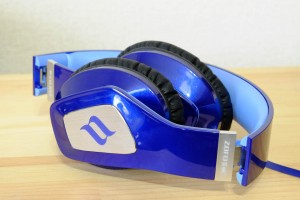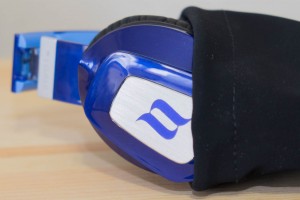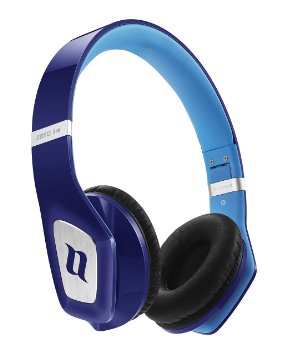It all started with a message asking me if I’d like a free review sample of some headphones from a creatively off-beat name. I had seen the name around Head-Fi and only guessed that they were inexpensive and may actually be half-decent. So I accepted. Later it turned out that they appeared to have given away quite a few pairs to people to review and that they were cheaper than expected. At $89.99 in blue or $99.99 in three other colour combinations they were on the end of the scale that I usually ignored except when a handful of cheap-headphone-spotters would start arguing about over them in the forums.

The small box that arrived with a front revealing-flap did not encourage me with the marketing on the front — “Surround Closed Cavity Body” (meaningless), “Votrik Speaker” (who?), “High Definition” (Ungh!). It brought back memories from decades ago of my $10 “Dyanmic Stereo Sound” speakers which had single drivers in a cheap plastic box. Inside the flap is a lot of very small writing going over the features which I felt were more relevant once I opened the box in which they were neatly folded, alongside a soft bag to put them in.
The hinge is steel reinforced, which is a positive given that the headphones are understandably plastic. The outer plastic is coated in what is described as “piano crafting varnish”. Considering the colours it looks more like the pearl car paint and is very nice and fingerprint-magnet smooth. On the headphones, which are “Designed in Italy”, the result is gorgeous. Garnering immediate positive comments from my young daughter when she spotted them. The headband arc ends at the hinge, with two tiny lugs protruding at the hinge that snap into place when the headphones are opened. I immediately worried about the durability of snapping and folding this daily a few times and reached out to Noontec to ask them about durability. They replied that they had tested the hinge and it didn’t have any problems after “5000 times test” [sic].

Noontec appears to have taken the time to make decent earpads. I’ve seen too many pairs of low-range headphones that had vinyl so thin that the earpads were destroyed in short order. So, decently thick earpads with a reasonably soft and smooth but a little robust-feeling covering was a pleasant surprise. The Zoro IIs sit on your ears, rather than around them, so this is important.
The fit and finish appears quite good, down to the cup swivels, which don’t
just flop around. The headphones don’t rattle when shaken and even when folded the hinges only have a tiny amount of play, only about as much as one gets in a high-end zoom lens. Even the single-button-with-mike phone-compatible cable is decent enough — a long strip of thin rubber terminated with branded plugs.
So all that was left to do was plug them into my iPhone 6 and have a listen.
My first impressions were a shock and not at all what I expected from a pair of cheap headphones. At a moderate listening level the music was quite detailed and crisp. My usual experience with cheap headphones is that they tend to be boomy with a poor mid-range and very rolled-off treble, which might be OK with modern brightly-mastered pop but is rubbish for just about anything else. More recent models seem to be moving away from this trend, but I found that one usually has to spend a couple of hundred dollars first.
Lately I’ve been going a bit retro and listening to Yello, specifically their latest album, Touch Yello. If you can imagine a slightly more modern version of the duo’s synth pop, this music welcomes detailed headphones and a good bit of bass punch. The album, ranging from dance tracks to ballads and soft jazz was delivered with both punch and delicacy as required. Heidi Happy’s voice, while not as well presented as with some of my headphones, still came through very well, more like what I’d expect from a more expensive pair of headphones. I think this is due to the treble being slightly muted, which can make vocals seem slightly muffled.
For the treble I broke out Leigh Barker from the Kostas Metaxas Recording Samplers to have a listen to the cymbals. While not coming through as strongly as with some headphones, there was nothing disagreeable about the presentation. Likewise I’d Rather Be Blind, Crippled and Crazy by The Derek Trucks Band was very enjoyable, the percussion delivered very well at both ends. If anything, like with Heidi Happy, I could only find fault in the vocals, which had a touch of hardness, but no more than I’d expect to find in more expensive headphones.
I broke out the Amon Tobin to test the deep bass. Bricolage contains a number of tracks that seem to go down close to 20 Hz. The rumble came through, not strongly, but quite sufficiently, and not lacking detail as I had expected. Likewise with The Silent Sound Spectrum by A Guy Called Gerald, which focuses on “very low and very high sounds” was not left lacking. However, their inexpensive build doesn’t fare quite as well when the volume is turned up to louder levels, with vibrations clearly coming through the frame and a bit of harshness appearing in the presentation. A great deal of this is due to them being on-ears. Regardless, they held up remarkably well considering their price.

Their overall tone is a touch warm, with a slightly reduced treble compared to regular “audiophile” headphones, which makes them a nice all-rounder for people who aren’t looking simply for deep, pounding bass all the time, or a “club” experience, for which I usually recommend V-MODAs. I found them remarkably enjoyable to listen with, as long as I didn’t turn the volume up too high. In fact, their presentation seemed to suit quieter listening levels quite well. Most unexpected was that I didn’t feel a desire to remove them from my head once I started listening, always an excellent sign. The slightly muted treble, while not perfect for some music, does make brighter, modern recordings less fatiguing.
For $90-100, these are definitely a good buy for someone looking for a pair of decent on-ear portables.















Reply
Want to join discussion?
Feel free to contribute!